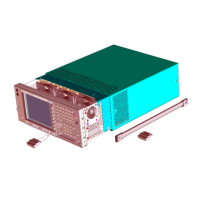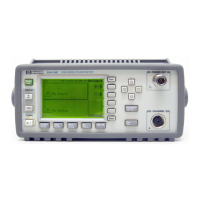
Do you have a question about the Agilent Technologies E4408B and is the answer not in the manual?
| Amplitude Accuracy | ±0.5 dB |
|---|---|
| Input Impedance | 50 Ohms |
| Sweep Time | 1 ms to 1000 s |
| Resolution Bandwidth (RBW) | 1 Hz to 3 MHz |
| Video Bandwidth (VBW) | 1 Hz to 3 MHz |
| Detectors | Peak, Sample |
| Interfaces | GPIB, LAN |
| Dimensions | 426 mm × 177 mm × 470 mm (16.8 in × 7.0 in × 18.5 in) |
| Amplitude Range | +30 dBm |
| Input VSWR | 1.5:1 |
| Third Order Intercept (TOI) | +15 dBm |
| Display | Color LCD |
Details AC and DC power requirements and specifications for analyzer operation.
Describes the three-wire power cable and grounding requirements for safe analyzer operation.
Guides the user through performing a basic measurement using the internal signal.
Explains the importance of internal alignment and warm-up time for analyzer accuracy.
Details test limits and procedures for measuring average noise level across frequency ranges.
Covers test limits, description, and required equipment for frequency readout accuracy testing.
Provides procedure and test limits for verifying marker count accuracy.
Details test limits, description, and required equipment for frequency response measurement.
Covers test limits, description, and required equipment for reference level accuracy.
Details test limits and procedures for measuring resolution bandwidth switching uncertainty.
Covers test limits, description, and required equipment for measuring scale fidelity.
Details test limits and description for second harmonic spurious responses.
Covers test limits, description, and required equipment for tracking generator level flatness.
Details test limits, description, and required equipment for tracking generator level flatness.
Lists preliminary checks to perform before contacting support or returning the analyzer.
Details procedures for returning the analyzer for servicing, including packaging.
Describes the four types of messages generated by the analyzer during operation.
Lists messages indicating conditions that may result in erroneous data.
Categorizes errors into Query, Device-Specific, Execution, and Command errors.
Details menu keys for placing markers on peaks and accessing measurement tools.
Provides starting points for measurements by selecting factory or user presets.
Activates amplitude menu keys for reference level, attenuation, and scale settings.
Controls resolution bandwidth, video bandwidth, and averaging functions.
Accesses detector functions, demodulation, speaker control, and FM gain.
Controls display elements like full screen, display line, and limits.
Provides access to keys for viewing, saving, loading, and managing data files.
Controls center, start, stop frequencies and frequency offset.
Configures input impedance, coupling, mixer types, and signal identification.
Controls marker functions: type, number, on/off, readout, and functions like Band Power.
Allows pausing, restarting, or toggling between continuous and single measurement sweeps.
Configures measurement parameters for ACP, Channel Power, Occupied BW, etc.
Accesses measurement modes like channel power, occupied bandwidth, and harmonic distortion.
Places markers on peaks and accesses tools for measuring signal characteristics.
Provides a starting point by selecting factory or user-defined analyzer presets.
Executes a save operation for analyzer setups, states, traces, and data.
Accesses tracking generator functions for power and sweep adjustments.
Activates sweep time function and accesses menu keys for sweep time and control.
Accesses System menu keys for local mode, error display, and analyzer settings.
Provides measurements for various digital communication standards.
Provides measurements for various international digital communications standards.












